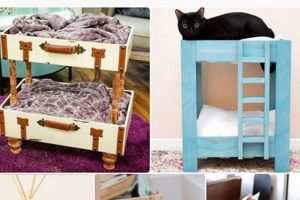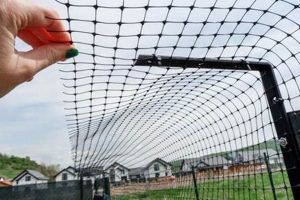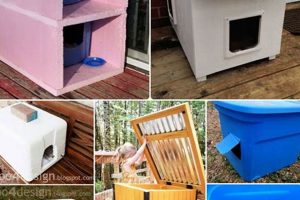Creating feline-themed attire at home involves the design and construction of pet apparel, typically for domestic cats, utilizing readily available materials and crafting techniques. Such projects range from simple alterations of existing garments to elaborate, fully constructed outfits. For example, transforming an old t-shirt into a vest with felt ears constitutes a basic instantiation.
The practice of outfitting pets in decorative apparel offers several advantages. It fosters creative expression and provides an avenue for engaging in personalized, hands-on activities. Furthermore, the resultant garments can contribute to lighthearted events such as costume parties or photographic opportunities, strengthening the bond between owner and animal. Historically, the custom of adorning animals dates back centuries, evolving from purely functional purposes, such as protection from the elements, to more aesthetic and celebratory applications.
The following sections will delve into specific strategies for fabricating inventive and safe ensembles for domestic felines, addressing material selection, construction methodologies, and crucial safety considerations.
Guidance for Feline Garment Creation
Effective and safe feline garment creation necessitates careful planning and execution. The following suggestions promote successful results and prioritize the well-being of the animal.
Tip 1: Prioritize Comfort and Safety: Feline garments should not impede movement, breathing, or vision. Avoid small parts that could be ingested, and ensure closures, such as snaps or Velcro, are secure but easily removable.
Tip 2: Select Appropriate Materials: Opt for soft, lightweight, and breathable fabrics, such as cotton or fleece. Avoid materials that could cause overheating, irritation, or allergic reactions. Consider washable options for ease of cleaning.
Tip 3: Measure Accurately: Precise measurements are crucial for a well-fitting garment. Measure the cat’s neck, chest, and length to determine the appropriate size. Add extra allowance for ease of movement and comfort.
Tip 4: Introduce the Garment Gradually: Allow the cat to become accustomed to the garment slowly. Begin by placing the item near the cat, then briefly draping it over them, before attempting full application. Reward positive behavior with treats and praise.
Tip 5: Supervise Usage: Never leave a cat unattended while wearing a garment. Monitor for signs of discomfort, distress, or overheating. Remove the garment immediately if any issues arise.
Tip 6: Keep it Simple: Elaborate designs might appear appealing, but simplicity often yields the best results. Focus on functionality and comfort over intricate embellishments, especially if the feline is unaccustomed to wearing apparel.
Tip 7: Design for Quick Removal: A garment should be easy to remove in case of emergency or if the cat becomes distressed. Avoid complex closures or designs that require significant time or effort to undo.
Careful consideration of comfort, safety, and gradual introduction enables the fabrication of feline garments that are both aesthetically pleasing and beneficial to the animal’s well-being.
The subsequent sections will explore specific garment designs and techniques in greater detail.
1. Material Selection
Material selection is a foundational element in the creation of homemade feline attire. The chosen fabrics and components directly impact the garment’s comfort, durability, and safety, thus influencing the overall success and well-being of the animal.
- Fabric Type and Breathability
The selection of breathable fabrics, such as cotton or lightweight fleece, prevents overheating and discomfort for the cat. Non-breathable materials like vinyl or heavy synthetics can trap heat, leading to potential health risks. Natural fibers are generally preferred for their ventilation properties and reduced likelihood of causing skin irritation.
- Allergenicity and Sensitivity
Certain fabrics can trigger allergic reactions in sensitive animals. Wool, for example, may cause itching or skin irritation in some cats. Hypoallergenic materials, such as organic cotton or bamboo fibers, are recommended for felines with known sensitivities to minimize adverse reactions.
- Durability and Washability
The chosen material must withstand regular wear and cleaning. Fabrics that are prone to tearing or shrinking after washing are unsuitable for feline attire. Durable and washable materials, like cotton blends, simplify maintenance and extend the garment’s lifespan, ensuring its ongoing use.
- Safety Components: Fasteners and Embellishments
The selection of fasteners and embellishments requires careful consideration. Small buttons, beads, or dangling elements pose a choking hazard if ingested. Secure, non-toxic closures, such as Velcro or snaps, are preferable. Embellishments should be securely attached to prevent detachment and potential ingestion, prioritizing the animal’s safety.
The aforementioned factors collectively highlight the critical relationship between material selection and the production of safe, comfortable, and functional feline attire. Prudent material choices mitigate potential health risks and contribute to a positive costuming experience for both the owner and the animal.
2. Measurement Accuracy
The creation of homemade feline apparel hinges substantially upon precise measurement accuracy. Inaccurate measurements directly contribute to ill-fitting garments, causing discomfort, restricted movement, or even potential injury to the animal. For instance, a neckline too small may impede breathing, while excessively long sleeves could hinder mobility, leading to tripping hazards. The correlation between accurate measurements and a well-executed “diy cat costume” is therefore a causal one, where input precision dictates output quality and pet safety.
Measurement accuracy in this context involves obtaining precise dimensions of the feline’s neck circumference, chest girth, back length (from neck to tail base), and leg length. These measurements then serve as the foundation for pattern drafting or garment alteration. Consider the scenario where chest girth is underestimated; the resulting garment risks being too tight, causing constriction and discomfort. Conversely, overestimated measurements result in a loose-fitting garment, prone to slipping off or becoming entangled in surrounding objects. The practical implications extend to the animal’s acceptance of the apparel; a comfortable, well-fitting garment is more likely to be tolerated by the cat, facilitating stress-free costuming.
In summary, measurement accuracy constitutes a crucial component within the domain of “diy cat costume” creation. It directly impacts garment fit, animal comfort, and overall safety. Overlooking this element jeopardizes the well-being of the feline and reduces the likelihood of successful attire. Therefore, meticulous measurement practices are essential for achieving functional and aesthetically pleasing homemade feline apparel.
3. Comfort Priority
The successful integration of “Comfort Priority” within the creation of a “diy cat costume” is not merely an aesthetic consideration, but a fundamental prerequisite for the well-being and acceptance of the attire by the animal. Disregarding the cat’s comfort can lead to stress, anxiety, and potential physical harm, rendering the costume counterproductive.
- Material Softness and Breathability
The direct contact of the fabric with the feline’s skin necessitates the selection of soft, breathable materials such as cotton or fleece. Rough or synthetic fabrics can cause irritation, itching, or overheating. The choice of a gentle and porous material allows for adequate ventilation and reduces the likelihood of skin reactions, directly contributing to the cat’s comfort level while wearing the costume. For instance, substituting a coarse wool blend with a soft cotton knit could significantly improve the cat’s tolerance of the garment.
- Garment Fit and Range of Motion
A well-fitting garment allows for a full range of motion, essential for the cat to perform normal activities such as walking, jumping, and grooming. Restrictive designs can impede these movements, causing discomfort and frustration. The costume should be tailored to the cat’s specific measurements, ensuring it is neither too tight nor too loose. A practical example involves creating armholes of adequate size to prevent chafing and allow unrestricted leg movement, thereby prioritizing the animal’s physical comfort and mobility.
- Weight and Bulk of Costume
The overall weight and bulk of the costume contribute significantly to the cat’s comfort. Heavy or bulky designs can be cumbersome and tiring to wear, especially for extended periods. Lightweight materials and streamlined designs are preferable, minimizing the physical burden on the animal. An example would be opting for a single-layer design over multiple layers of heavy fabric, thereby reducing the overall weight and bulk of the finished costume and increasing the cat’s comfort.
- Minimizing Obstructions to Sensory Perception
A crucial aspect of comfort involves ensuring the costume does not impede the cat’s sensory perception. Elements that obstruct vision, hearing, or the ability to groom can cause anxiety and disorientation. The design should avoid covering the eyes, ears, or sensitive areas around the face. For example, refraining from attaching dangling ornaments near the cat’s face prevents sensory overload and maintains the cat’s awareness of its surroundings, contributing to a sense of security and comfort.
The aforementioned considerations collectively underscore the critical role of “Comfort Priority” in the domain of “diy cat costume” creation. By meticulously addressing each facet, from material selection to design implementation, the resulting garment is more likely to be well-received by the feline, fostering a positive and stress-free experience. Prioritizing comfort not only enhances the animal’s well-being but also improves the overall success of the costuming endeavor.
4. Safety Fasteners
The integration of secure and easily releasable fasteners constitutes a critical safety component in the construction of homemade feline attire. The connection between appropriate fastening mechanisms and the overall safety profile of a “diy cat costume” is direct and consequential. Ill-conceived or improperly implemented fasteners can pose significant risks to the animal, ranging from minor discomfort to potential injury or even life-threatening situations. For instance, a fastener that becomes snagged on an object could restrict movement, leading to panic or, in extreme cases, strangulation. Therefore, the careful selection and application of “Safety Fasteners” represents a non-negotiable aspect of responsible feline garment creation.
Practical application of this principle manifests in several key areas. First, the choice of fastener material is paramount. Alternatives to small buttons or hooks and eyes, which pose ingestion hazards, include Velcro strips or appropriately sized snaps. Second, the positioning of fasteners must minimize the risk of entanglement. Fasteners placed near the animal’s extremities or where they are likely to rub against objects are particularly hazardous. Third, the design should allow for quick and easy removal by the owner in case of emergency. Complex or multi-layered fastening systems may impede swift intervention, exacerbating a dangerous situation. An example might include using breakaway clasps, commonly found on cat collars, incorporated into the design of a vest or cape.
In summation, the careful consideration of “Safety Fasteners” is paramount in the context of a “diy cat costume”. The selection and placement of these components directly influence the animal’s safety and well-being. Challenges may include sourcing appropriate materials, mastering secure attachment techniques, and balancing functionality with aesthetic appeal. However, prioritizing safety through the implementation of well-designed fastening mechanisms is crucial, linking directly to the broader theme of responsible pet ownership and humane animal care. Ignoring this aspect can result in preventable harm and undermines the very purpose of creating homemade feline attire.
5. Simple Design
Within the domain of “diy cat costume,” the adoption of a “Simple Design” philosophy is not merely an aesthetic preference, but a pragmatic imperative directly impacting animal welfare and project feasibility. Complex constructions introduce increased opportunities for discomfort, restricted movement, and potential hazards. In contrast, simplified designs minimize these risks, facilitating the creation of safe and tolerable attire. A direct causal link exists: intricate designs necessitate more intricate fastening systems, which can pose entanglement hazards. Furthermore, complicated patterns demand advanced crafting skills, potentially deterring novice creators and limiting the accessibility of “diy cat costume” projects. Examples of successful implementations of “Simple Design” include capes secured with a single Velcro closure, vests constructed from repurposed t-shirts, and headbands featuring basic felt embellishments. These illustrate how minimal design translates to increased safety and ease of execution. The practical significance of embracing “Simple Design” lies in its ability to lower the barrier to entry for aspiring costume makers while simultaneously prioritizing the well-being of the feline participant.
Further analysis reveals that simplified designs also contribute to increased tolerance from the cat. Intricate costumes often involve multiple layers, tight fits, or restrictive elements, leading to stress and resistance from the animal. Simple designs, characterized by lightweight materials, loose fits, and minimal embellishments, minimize these negative stimuli. A practical application involves reducing the number of attachment points to only the essential, such as using a single strap under the chest instead of multiple straps across the back. This reduces the feeling of constraint and increases the likelihood of the cat accepting the garment. Moreover, simplified designs allow for easier monitoring and adjustment, enabling owners to quickly address any signs of discomfort or distress.
In conclusion, the “Simple Design” principle is crucial to the success and safety of any “diy cat costume” project. It directly affects the complexity of construction, the likelihood of animal acceptance, and the overall risk of harm. Challenges in implementing this principle may involve resisting the urge to over-embellish or compromise on safety for the sake of visual appeal. However, by prioritizing simplicity, creators ensure that their “diy cat costume” efforts are both enjoyable and ethically sound, aligning with the broader theme of responsible pet ownership.
6. Gradual Introduction
The success of any “diy cat costume” endeavor is intrinsically linked to the implementation of “Gradual Introduction”. Immediate imposition of unfamiliar garments upon felines typically results in stress, anxiety, and resistance, negating the project’s intent. A phased acclimation process mitigates such adverse reactions, fostering tolerance and acceptance of the attire. The cause-and-effect relationship is clear: abrupt costuming leads to negative associations, while measured introduction cultivates positive or neutral perceptions. This component is essential, functioning as the cornerstone of responsible feline costuming.
Practical application of “Gradual Introduction” necessitates a structured approach. Initially, the garment should be presented to the cat without any attempt at application, allowing for visual and olfactory familiarization. Subsequent steps involve brief draping of the costume over the cat’s back, followed by immediate removal and positive reinforcement through treats or praise. The duration of each exposure should be incrementally increased, contingent upon the animal’s behavioral cues. For instance, if the cat remains calm and displays no signs of distress, the exposure time can be extended. Conversely, any indications of anxiety warrant an immediate return to the previous stage. Examples of this approach include beginning with a simple bandana, gradually progressing to more complex garments as the cat exhibits increasing tolerance.
In summary, “Gradual Introduction” represents a crucial determinant of success in “diy cat costume” projects. This approach is directly linked to the feline’s comfort, safety, and overall well-being. The primary challenge lies in adhering to the animal’s individual pace and responding appropriately to its behavioral signals. By embracing a patient and measured introduction process, creators can minimize stress and maximize the likelihood of a positive costuming experience, aligning with the overarching theme of responsible pet ownership and animal welfare.
7. Supervised Usage
The concept of “Supervised Usage” assumes a central position within the context of “diy cat costume”, acting as a crucial safeguard against potential harm. The relationship between the two is fundamentally causal; a lack of supervision directly elevates the risk of injury, distress, or even life-threatening situations for the feline. A “diy cat costume,” by its very nature, introduces novel elements into the animal’s environment, elements that may impede movement, obstruct vision, or present choking hazards. Consequently, constant monitoring becomes essential to ensure the animal’s safety and well-being during periods of costume wear.
Real-life examples illustrate the importance of “Supervised Usage.” A cat left unattended while wearing a costume with elastic components could become entangled, leading to restricted breathing or circulation. Similarly, unsupervised access to a costume featuring small, detachable embellishments carries the risk of ingestion and subsequent gastrointestinal distress. The practical significance of understanding this connection lies in proactive risk mitigation. Owners must actively observe their cats for signs of discomfort, anxiety, or physical impairment. Adjustments to the costume, or even immediate removal, should be prompted by any indication of distress. Furthermore, supervision allows for timely intervention in the event of unexpected hazards, such as the costume becoming snagged on furniture.
In conclusion, “Supervised Usage” is an indispensable component of responsible “diy cat costume” practices. Challenges may arise in maintaining constant vigilance, particularly during social gatherings or photographic sessions. However, prioritizing animal safety above aesthetic considerations represents a fundamental ethical obligation. By consistently adhering to the principle of “Supervised Usage,” owners can minimize potential risks and ensure that the “diy cat costume” experience remains both enjoyable and safe for the feline participant, thereby reinforcing the broader theme of responsible pet ownership and humane animal care.
Frequently Asked Questions
This section addresses common inquiries regarding the creation and implementation of homemade feline attire, providing clear and concise information.
Question 1: What materials are unsuitable for the creation of “diy cat costume”?
Materials presenting potential choking hazards, such as small buttons or beads, and fabrics causing skin irritation, like coarse wool, are inappropriate. Heavy, non-breathable synthetics are also discouraged due to the risk of overheating. Sharp components are strictly prohibited.
Question 2: How does one ensure a secure yet easily removable closure for a “diy cat costume”?
Velcro strips or appropriately sized snaps represent viable options. The placement of closures should minimize the risk of entanglement, and the design must facilitate swift removal by the owner in emergency situations. Elastic closures are not recommended due to the strangulation risk.
Question 3: What are the primary indicators of distress in a cat wearing a “diy cat costume”?
Observable signs include excessive vocalization, attempts to remove the garment, flattened ears, dilated pupils, agitated tail movements, and labored breathing. Any of these symptoms warrant immediate removal of the costume.
Question 4: How can the process of introducing a “diy cat costume” be optimized for feline acceptance?
A gradual approach is recommended. Initial familiarization with the garment’s scent and presence should precede brief draping, followed by positive reinforcement through treats or praise. Exposure time should be incrementally increased, contingent upon the animal’s behavioral cues.
Question 5: What are the implications of neglecting proper measurement accuracy in “diy cat costume” construction?
Inaccurate measurements contribute to ill-fitting garments, potentially restricting movement, impeding breathing, or causing chafing. A costume that is too tight or too loose poses significant safety risks and compromises the animal’s comfort.
Question 6: What constitutes appropriate supervision during “diy cat costume” usage?
Active observation of the animal for signs of distress, entanglement, or physical impairment is essential. Unattended costume wear is strictly discouraged. Immediate intervention is required in the event of any observed difficulties.
In summary, the creation and implementation of a “diy cat costume” requires careful attention to material selection, design, fitting, and safety protocols. Prioritizing the animal’s well-being is paramount.
The subsequent sections will delve into advanced techniques and creative design options for feline apparel.
Conclusion
The preceding examination of “diy cat costume” has underscored the complexities inherent in creating safe and comfortable apparel for domestic felines. Critical considerations encompass material selection, measurement accuracy, comfort prioritization, secure fastening mechanisms, design simplicity, gradual introduction techniques, and the necessity of supervised usage. Each element plays a pivotal role in ensuring the animal’s well-being and acceptance of the attire.
Responsible pet ownership necessitates a commitment to prioritizing animal welfare above aesthetic considerations. Future endeavors in crafting feline garments should emphasize continuous improvement in safety protocols and design innovation, thereby fostering a harmonious balance between human creativity and animal comfort. The ultimate success of any “diy cat costume” project hinges on the ethical imperative to minimize risk and maximize the feline’s overall experience.







